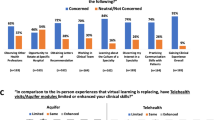Abstract
Nurses working in oncology require continuing education and nowadays distance education is a possibility. To compare learning outcomes of the professionals participating in classroom learning versus distance learning; describing the sociodemographic characteristics and digital fluency of participants; comparing learning outcomes with independent variables; assessing the adequacy of educational practices in Virtual Environment Moodle Learning through the constructivist online learning environment survey. An experimental, randomized controlled study; conducted at the A C Camargo Cancer Center, located in São Paulo, SP, Brazil. The study included 97 nurses, with average training of 1 to 2 years. A control group (n = 44) had face to face training and the experiment group (n = 53) had training by distance learning, both with identical program content. The dependent variable was the result of learning, measured by applying a pre-assessment questionnaire and post-intervention for both groups. The sociodemographic and digital fluency data were uniform among the groups. The performance of both groups was statistically significant (p 0.005), and the control group had a greater advantage (40.4 %). Distance education has proven to be an effective alternative for training nurses, especially when they have more complex knowledge, more experience in the area and institutional time. Distance Education may be a possibility for the training of nurses for work in oncology. The association of age, training time and the institution, and the experience in Oncology interfered in the performance of both groups.
Similar content being viewed by others
References
Ana Maria C, Claudia P (2010) Teaching of oncology in nurse’s education. Rev Bras Enferm. doi:10.1590/S0034-71672009000300022
Faiman B (2011) Overview and experiences of a nursing e-mentorship program. Clin J Oncol Nurs. doi:10.1188/11.CJON.418-423
Militello LK, Aldrich B, Heather, Rabah K (2012) A methodological quality synthesis of systematic reviews on computer-mediated continuing education for healthcare providers. Worldviews Evid.-Based Nurs. doi: 10.1111/wvn.12041
Shigeko H, Yukari Y, Miki K, Yumi S, Kazuhiro N (2009) Evaluation of a web-based graduate continuing nursing education program in Japan: a randomized controlled trial. Nurse Educ Today. doi:10.1016/j.nedt.2008.08.009
Du S, Liu Z, Liu S, Yin, Xu G, Zhang H, Wang A (2013) Web-based distance learning for nurse education: a systematic review. Int Nurs Rev. doi:10.1111/inr.12015
Bloomfield JG, While AE, Roberts JD (2008) Using computer assisted learning for clinical skills education in nursing: integrative review. J Adv Nurs. doi:10.1111/j.1365-2648.2008.04653.x
Hasson F, Keeney S, McKenna H (2000) Research guidelines for the Delphi survey technique. J Adv Nurs. doi:10.1046/j.1365-2648.2000.t01-1-01567.x
Wen-Yin C, Shu-Tai Hsiao S, Pi-Chen C, Pi-Hsia L (2008) Developing an E-learning education programme for staff nurses: processes and outcomes. Nurse Educ Today. doi:10.1016/j.nedt.2008.02.003
Taylor P, Maor D (2000) Assessing the efficacy of online teaching with thecontructivist online learning environment survey. Paper presented at: flexible futures in tertiary teaching 9th annual teaching learning forum perth; Austrália. [proceedings on the internet]. PhilSci archive. http://researchrepository.murdoch.edu.au/8750/1/TL_Forum_2000__Taylor_and_Maor_-_the_Constructivist_On Line_Learning_Environment_Survey.pdf. Accessed 20 de June 2013
Demei S, Moon-Heum C, Chia-Lin T, Rose M (2013) Unpacking online learning experiences: online learning self-efficacy and learning\satisfaction. Internet Higher Educ. doi:10.1016/j.iheduc.2013.04.001
Blake R, Wilson NL, Cetto MC, Pardo-Ballester C (2008) Measuring oral proficiency in distance, face-to-face, and blended classrooms. Lang Learn Technol. PhilSci archive. http://llt.msu.edu/vol12num3/blakeetal/. Accessed 01 de Ago 2013
Beth M-S, Jerri P, Pamela L (2015) Online teaching: “are you there, and do you care?”. J Nurs Educ. doi:10.3928/01484834-20150218-18, See comment in PubMed Commons belowVeja comentário na PubMed Commons abaixoJ Nurs Educ. 2015 Mar;54(3):145-51.. 2015
Kelly A, Blake RJ (2012) Individual factors and successful learning in a hybrid course. System. doi:10.1016/j.system.2012.10.013
Christopher C, Andrew B, Diana P, Athea S, Rutth W (2009) UK health-care professionals’ experience of on-line learning techniques: a systematic review of qualitative data. J Contin Educ Health Prof. doi:10.1002/0chp.20041
Inge AP, Rob FP, Marjolein GMC, Olle TC (2015) Strategies for continuing professional development among younger, middle-aged, and older nurses: a biographical. Int J Nurs Stud. doi:10.1016/j.ijnurstu.2015.02.004
Silvia Wen-Yu L (2013) The effectiveness of an e-learning program on pediatric medication safety for undergraduate students: a pretest-post-test intervention study. Nurse Educ Today. doi:10.1016/j.compedu.2013.05.019
Whittaker AA (2015) Effects of team-based learning on self-regulated online learning. Int J Nurs Educ Scholarsh. doi:10.1515/ijnes-2014-0046
Henny B (2013) Virtual collaboration in the online educational setting: a concept analysis. Nurs Forum. doi:10.1111/nuf.12034
Garonce F, Santos GL (2012). Mediatic transposition: from conventional classroom to face-connected classroom. Educação & Sociedade. PhilSci archive. http://www.cedes.unicamp.br. Accessed 01 de Ago 2013
Sowan AK, Jenkins LS (2013) Designing, delivering and evaluating a distance learning nursing course responsive to students needs. Int J Med Inform. doi:10.1016/j.ijmedinf.2013.02.004. Epub 2013 Mar 9
Petty J (2013) Interactive, technology-enhanced self-regulated learning tools in healthcare education: a literature review. Nurse Educ Today. doi:10.1016/j.nedt.2012.06.008
Author information
Authors and Affiliations
Corresponding author
Rights and permissions
About this article
Cite this article
das Graças Silva Matsubara, M., De Domenico, E.B.L. Virtual Learning Environment in Continuing Education for Nursing in Oncology: an Experimental Study. J Canc Educ 31, 804–810 (2016). https://doi.org/10.1007/s13187-015-0889-x
Published:
Issue Date:
DOI: https://doi.org/10.1007/s13187-015-0889-x




